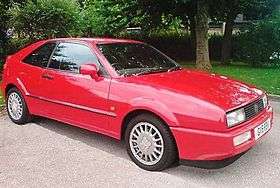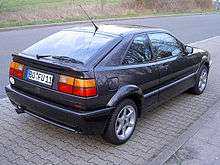Volkswagen Corrado
The Volkswagen Corrado is a compact four passenger (2+2), three door, front engine, front wheel drive liftback coupe marketed by Volkswagen from 1988 to 1995, and manufactured by Karmann in Osnabrück, Germany.
| Volkswagen Corrado | |
|---|---|
 | |
| Overview | |
| Manufacturer | Volkswagen |
| Production | 1988–1995 |
| Assembly | Germany: Osnabrück (Karmann) |
| Designer | Herbert Schäfer |
| Body and chassis | |
| Class | Sport compact |
| Body style | 3-door coupé |
| Layout | Front-engine, front-wheel-drive |
| Platform | Volkswagen Group A2 platform |
| Related | Volkswagen Golf Mk2 Volkswagen Jetta Mk2 SEAT Toledo Mk1 |
| Powertrain | |
| Engine | 1.8 L I4 (petrol) 1.8 L supercharged I4 (petrol) 2.0 L I4 (petrol) 2.8 L VR6 (petrol) 2.9 L VR6 (petrol) |
| Transmission | 5-speed manual 4-speed automatic |
| Dimensions | |
| Wheelbase | 1989–1992: 2,471 mm (97.3 in) 1993–1995: 2,469 mm (97.2 in) |
| Length | 4,049 mm (159.4 in) |
| Width | 1989–1992: 1,674 mm (65.9 in) 1993–1995: 1,689 mm (66.5 in) |
| Height | 1,310 mm (51.57 in) |
| Curb weight | 1,210–1,274 kg (2,668–2,809 lb) |
| Chronology | |
| Predecessor | Volkswagen Scirocco Mk.2 |
| Successor | Volkswagen Scirocco Mk.3 |
Designed by Herbert Schäfer,[1] the Corrado overlapped and eventually superseded Volkswagen's Scirocco model. 97,521 Corrados were manufactured[2] over the seven year production run.
Overview

The Corrado's floorpan is based on the A2 platform (i.e. Mark 2 Golf/Jetta) and, with the exception of VR6 models, all versions use the subframes, suspension, steering and braking components from the Volkswagen A2 platform model range.
The VR6 uses suspension components from the A3 model range, including the rear axle assembly and some parts of the A3's 'plus' type front axle assembly. The subsequent wider front wheel track of the Corrado VR6 necessitated the fitting of new front wings with wider wheel arches and liners along with a new front bumper assembly.
The Corrado is noted for its flush mounted windows and active rear spoiler – which raises automatically when the car exceeds 100 km/h (60 mph) (45 mph or 72 km/h in the North American market), automatically retracts at speeds below 25 km/h (15 mph) or can be manually controlled by the driver.[3]
Variants
Launched in the end of 1988 (three years before the end of Scirocco production), all Corrados were front-wheel drive and featured petrol engines. The Corrado debuted with two engine choices: a 1.8 litre 16-valve inline four with 136 PS (100 kW; 134 hp) (KR),[4][5] and a supercharged 1.8 litre eight valve inline four, marketed as the G60 and delivering 160 PS (118 kW; 158 hp).
The Corrado G60 is named for the G Lader with which it is equipped, a scroll supercharger whose interior resembles the letter "G".
There were also two special models of the G60. The G60 Jet was an economy version for the German market only, thought to be a run out model before the introduction of the VR6. This model was only available in four colours and featured a colour coded interior. Sadly, Volkswagen could not confirm production numbers for the Jet model.
Another variant is Volkswagen Motorsport (VWMS) Corrado 16V G60. Although the 16 valve engine combined with the original G-Lader was appreciated within the enthusiast community, the model never saw series production. It is generally believed that only two factory built examples were manufactured, both in Nugget Yellow.
Volkswagen introduced two new engines for 1992. The first was a naturally aspirated 2.0 litre, 16 valve 136 PS (100 kW; 134 hp) inline four, basically a further development of the 1.8 litre engine; this engine was not made available to the North American market.
The second was the twelve valve VR6 engine, which came in two variants: a 2.8 litre 179 bhp (133 kW; 181 PS) model for the United States and Canadian markets, and a 2,861 cc (2.9 L; 174.6 cu in) producing 190 PS (187 bhp; 140 kW) at 5,800 rpm and 245 N⋅m (181 lbf⋅ft) at 4,200 rpm of torque version for the European market, fuel feed by Bosch Motronic 2.7 fuel injection.[6] In the United States, the model VR6 was marketed as the Corrado SLC (sport luxury coupe).
Upon revising the engine, Volkswagen updated the styling with a new front grill and foglamps.[7] With the introduction of the VR6 engine, the G60 engine disappeared from the North American market after 1992 and European market in 1993. The VR6 engine provided a compromise between both V shaped and straight engines by placing the two cylinder banks at an angle of 15°, with a single cylinder head.
This design allowed engineers to fit a six cylinder engine into roughly the space previously occupied by four cylinder engines, while closely approaching the smoothness of a straight six design. 1994 was the last model year of the Corrado in the United States.
A 2.0 litre eight valve model 115 PS (85 kW; 113 hp) was produced in Europe in 1995. A limited edition only for the United Kingdom, the Corrado Storm, was also sold. Some discreet "Storm" badging, a colour keyed front grille, an additional Storm badge on the gear gaiter surround (an upgrade from the standard Karmann badge), 15 inch BBS "Solitude" alloy wheels, and standard fitment of some previously optional items (such as the leather heated front seats) differentiated this model from the base Corrado VR6.
Only five hundred were produced: 250 in Classic Green with a cream leather interior, and 250 in Mystic Blue, a colour unique to the Storm, with a black leather interior. The Campaign model was made only in 1992. It was a VR6 Corrado available solely with Dusty Mauve Pearl Effect paint and a brick red leather interior, and only six were ever produced.
The Corrado was offered in Japan at Yanase dealerships that specialize in North American and European vehicles, offering the 1.8 L engine with either the automatic or manual transmission. The larger VR6 would have been considerably more expensive to tax, as the engine was over two liters' displacement.
| Model | Years | Displacement | Peak power | Peak torque | Top speed | Acceleration 0–100 km/h (0-62 mph) |
|---|---|---|---|---|---|---|
| 1.8 16V | 1989–1992 | 1,781 cc (108.7 cu in) | 100 kW (136 PS; 134 hp) at 6300 rpm | 162 N⋅m (119 lb⋅ft) at 4800 rpm | 210 km/h (130 mph) | 9.1 s |
| 1.8 8V G60 | 1989–1993 | 118 kW (160 PS; 158 hp) at 5600 rpm | 225 N⋅m (166 lb⋅ft) at 4000 rpm | 225 km/h (140 mph) | 8.5 s | |
| 2.0 8V | 1993–1995 | 1,984 cc (121.1 cu in) | 85 kW (116 PS; 114 hp) at 5400 rpm | 166 N⋅m (122 lb⋅ft) at 3200 rpm | 200 km/h (124 mph) (manual) 196 km/h (122 mph) (auto) | 10.6 s (manual) 11.5 s (auto) |
| 2.0 16V | 1992–1995 | 100 kW (136 PS; 134 hp) at 5800 rpm | 180 N⋅m (133 lb⋅ft) at 4400 rpm | 210 km/h (130 mph) (manual) 208 km/h (129 mph) (auto) | 9.3 s (manual) 9.9 s (auto) | |
| 2.8 12V VR6 | 1991–1995 | 2,781 cc (169.7 cu in) | 131 kW (178 PS; 176 hp) at 5800 rpm | 235 N⋅m (173 lb⋅ft) at 4200 rpm | 230 km/h (143 mph) | 7.2 s |
| 2.9 12V VR6 | 1991–1995 | 2,861 cc (174.6 cu in) | 140 kW (190 PS; 188 hp) at 5800 rpm | 245 N⋅m (181 lb⋅ft) at 4200 rpm | 233 km/h (145 mph) (manual) 230 km/h (143 mph) (auto) | 6.9 s (manual) 7.9 s (auto) |
Reviews
Auto Express magazine describe it as "Regarded as one of VW’s best ever drivers’ cars".[3] The VR6 model was listed as one of the "25 Cars You Must Drive Before You Die" by the British magazine Car, and 'By far the most desirable version of the Corrado' by Auto Express.[3]
In MSN Autos 'Cool Cars We Miss' feature they listed the Corrado among the top eight "Gone but not forgotten: a short list of cars once loved, still missed", describing it in the following manner: "The VW Corrado VR6 is coveted because of its seductive styling, road handling capabilities and its role as trailblazer, introducing the VR6 to the American market."[8]
In 1988, in the first incarnation of the BBC television show Top Gear, racing car driver and presenter Tiff Needell reviewed the Corrado in G60 form, giving it a positive review and stating that "Handling wise, the Corrado is classic front wheel drive, and it's really very, very good indeed." In November 2003, in Series 3 of the relaunched Top Gear, presenter Richard Hammond identified the Corrado as a future classic, "a kind of classic waiting in the wings... I think it's really rather special... the result is fantastic."[9]
He also stated that the Corrado "was too expensive, and nobody bought it".
References
- "Archived copy". Archived from the original on 5 July 2017. Retrieved 3 April 2013.CS1 maint: archived copy as title (link)
- "Corrado G60 History".
- "Eighties classics | Used Car Tests | Car Reviews". Auto Express. 20 February 2008. Retrieved 15 March 2012.
- Mastrostefano, Raffaele, ed. (1990). Quattroruote: Tutte le Auto del Mondo 1990 (in Italian). Milano: Editoriale Domus S.p.A. p. 1137.
- "Volkswagen Corrado (89-96) 1.8 16V 3d - MPG, Dimensions & Performance". Parkers. 1 January 1992. Retrieved 25 May 2012.
- "1992 Volkswagen Corrado VR6". carfolio.com. Retrieved 24 July 2018.
- http://consumerguide.com/used/1990-94-volkswagen-corrado/
- Griffey, Evan (22 August 2011). "Cool Cars We Miss - MSN Autos". Editorial.autos.msn.com. Archived from the original on 2 October 2011. Retrieved 15 March 2012.
- "The one with... the unbreakable Hilux - BBC Top Gear". Topgear.com. Retrieved 15 March 2012.